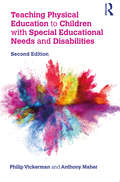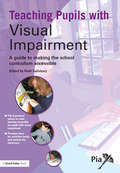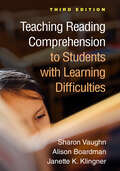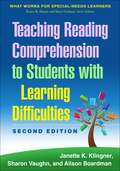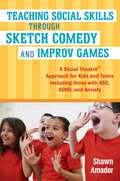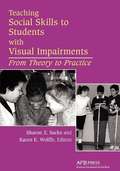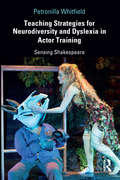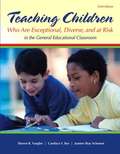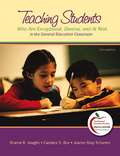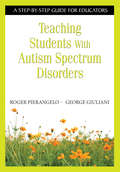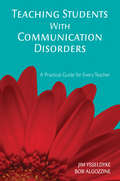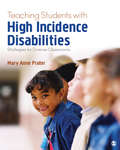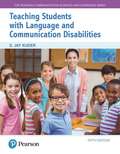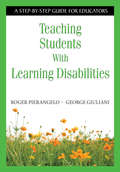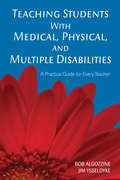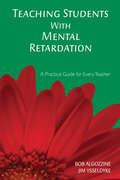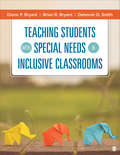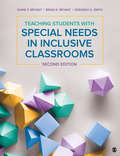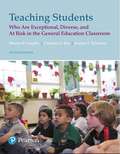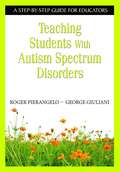- Table View
- List View
Teaching Physical Education to Children with Special Educational Needs and Disabilities
by Philip Vickerman Anthony MaherTeaching Physical Education to Children with Special Educational Needs and Disabilities provides a thorough overview of the challenges and opportunities for inclusion in PE lessons. Combining a theoretical framework with practical strategies for teachers, the title covers a diverse range of issues which teachers need to address to provide high quality learning experiences for children with SEND. This second edition is grounded in up-to-date research on inclusion and has been fully updated in line with the SEND Code of Practice and Ofsted Inspection Framework. It seeks to demystify the statutory responsibilities placed upon teachers and schools to include children with SEND and offers practical examples of how PE teachers can make use of different strategies to differentiate through their planning and assessment. A new chapter explores the importance of consulting with and empowering children with SEND, and additional focus is given to how teachers can work together with SENCOs and LSAs to develop an inclusive culture in PE lessons. Written in an accessible style with reflective tasks in each chapter, this unique text clearly outlines relevant practice-based evidence to fully include children with SEND in PE lessons. This will be essential reading for teachers and school leaders and will enable PE teachers to plan and deliver inclusive lessons for all children.
Teaching Primary Special Educational Needs
by Jonathan Glazzard Alison Hughes Annette Netherwood Lesley Neve Jane StokoeToday, there is increased emphasis on the coverage of special educational needs in initial teacher training. This comprehensive introduction begins by looking at inclusion policy and how barriers to achievement can be removed. The SEN Code of Conduct is explained and detailed guidance on Individual Education Plans (IEPs) is included. The book then goes on to give practical advice on the teaching of children with special educational needs in reading, speech and language, the autistic spectrum and behavioural, social and emotional difficulties. Finally, the book considers the wider context looking at partnerships with parents, carers and professionals in other agencies.
Teaching Pupils with Visual Impairment: A Guide to Making the School Curriculum Accessible (Access and Achievement)
by Ruth SalisburyBursting with practical advice, suggestions and handy tips, providing readers with a positive starting point for sharing ideas and good practice, this is a key practical guide to making learning accessible for primary and secondary school pupils with visual impairment. This user-friendly book shows how, with appropriate support, pupils with visual impairment in mainstream schools can have as rewarding an experience of education as their sighted peers. The majority of contributors are qualified teachers for visual impairment, with many years' experience working with pupils in a variety of settings. Covering the curriculum and each subject area in detail, Teaching Pupils with Visual Impairment includes guidance on: activities within and outside the classroom making the school's physical environment accessible inclusion within the school's social environment. Teachers and support staff will have immediate access to a wealth of ideas, supported by invaluable resources on the accompanying CD/website, including a complete electronic version of the book in large print, allowing older pupils to take a more active role in the learning process.
Teaching Reading Comprehension to Students with Learning Difficulties (The Guilford Series on Intensive Instruction)
by Sharon Vaughn Janette K. Klingner Alison BoardmanNow in a revised and expanded third edition, this important resource helps teachers understand how good readers comprehend text and how best to support students who are struggling. It presents effective instructional methods for learners at all grade levels, including those with reading disabilities. Every chapter translates state-of-the-art research into practical classroom applications. All facets of comprehension are addressed, including assessment, vocabulary, background knowledge, and text structure. Chapters also cover English learners, intensive intervention, and content literacy. Utility as a teacher guide and course text is enhanced by sample lesson plans, graphic organizers, and chapter-opening study questions. New to This Edition *Chapter on text selection and text structure. *Chapter on teachers' frequently asked questions, providing specific, actionable advice. *More than twice as many sample lesson plans. *Revised throughout with the latest research and teaching techniques.
Teaching Reading Comprehension to Students with Learning Difficulties, 2/E
by Sharon Vaughn Janette K. Klingner Alison BoardmanThis practitioner resource and course text has given thousands of K-12 teachers evidence-based tools for helping students--particularly those at risk for reading difficulties--understand and acquire new knowledge from text. The authors present a range of scientifically validated instructional techniques and activities, complete with helpful classroom examples and sample lessons. The book describes ways to assess comprehension, build the skills that good readers rely on, and teach students to use multiple comprehension strategies flexibly and effectively. Each chapter features thought-provoking discussion questions. Reproducible lesson plans and graphic organizers can be downloaded and printed in a convenient 8 1/2" x 11" size. New to This Edition *Chapters on content-area literacy, English language learners, and intensive interventions. *Incorporates current research on each component of reading comprehension. *Discusses ways to align instruction with the Common Core State Standards. *Additional instructional activities throughout.
Teaching Reading to All Learners Including Those with Complex Needs: A Framework for Progression within an Inclusive Reading Curriculum (nasen spotlight)
by Sarah MoseleyLearning to read and having access to a rich reading curriculum has a huge impact upon us both emotionally and academically. so how can we ensure that it is seen as an entitlement of all learners, including those defined as having profound and multiple learning difficulties (PMLD) and the most complex needs? This accessible book provides professionals with the knowledge and confidence to develop reading for all learners. It integrates the latest ideas and research into a practical framework to create an inclusive reading curriculum and support learners across the whole education spectrum, including those with the most complex needs. Each chapter includes a mixture of research, strategies, and case study examples, demonstrating how reading supports both wellbeing and access to learning and - with stories - provides a versatile vehicle to build on vocabulary and expand our ability to think and learn about our place in the world. Teaching Reading to All Learners Including Those with Complex Needs is essential reading for both new and experienced teachers and special educational needs and disabilities coordinators (SENDCo)s looking to develop an inclusive reading curriculum and culture which will positively impact on the outcomes of all young people.
Teaching Social Skills Through Sketch Comedy and Improv Games: A Social Theatre® Approach For Kids And Teens Including Those With Asd, Adhd, And Anxiety
by Shawn AmadorIntroducing a Social Theatre™, this book provides guidance on how to deliver fun and transformative activities to develop social skills in teenagers and children. Drawing on ideas from Social Thinking®, CBT, mindfulness and assertiveness training this book develops games, skits and short plays which can be adapted to suit children and teenagers including those who are gifted, typical, and those with mild to moderate cognitive abilities. These activities will help participants become more assertive and flexible as well as improving confidence, focus and self-esteem. Social Theatre™ can be used in small groups, in class or throughout the school, as well as in group therapy sessions. It provides a new and inclusive way to teach social skills and collaborative learning and is especially useful for those with anxiety, ADHD and ASD.
Teaching Social Skills to Students with Visual Impairments: From Theory to Practice
by Karen E. Wolffe Sharon Z. SacksHow do children become social beings? When a child is unable to observe visually and imitate how other people react and interact, this complex developmental process can become fragmented and incomplete. As a result, providing specific information, direct instruction, and opportunities for social interaction to children who are blind or visually impaired is critical to their growth and education. Edited by two groundbreaking educators and researchers, with contributions from other outstanding educators and researchers in this area, Teaching Social Skills to Students with Visual Impairments explores what theory can tell us about how children who are visually impaired become socially skilled individuals. It then presents a compendium of techniques and strategies for helping youngsters, from preschoolers through young adults, including those with additional disabilities, develop and refine social skills.
Teaching Strategies for Neurodiversity and Dyslexia in Actor Training: Sensing Shakespeare
by Petronilla WhitfieldTeaching Strategies for Neurodiversity and Dyslexia in Actor Training addresses some of the challenges met by acting students with dyslexia and highlights the abilities demonstrated by individuals with specific learning differences in actor training. The book offers six tested teaching strategies, created from practical and theoretical research investigations with dyslexic acting students, using the methodologies of case study and action research. Utilizing Shakespeare’s text as a laboratory of practice and drawing directly from the voices and practical work of the dyslexic students themselves, the book explores: the stress caused by dyslexia and how the teacher might ameliorate it through changes in their practice the theories and discourse surrounding the label of dyslexia the visual, kinaesthetic, and multisensory processing preferences demonstrated by some acting students assessed as dyslexic acting approaches for engaging with Shakespeare’s language, enabling those with dyslexia to develop their authentic voice and abilities a grounding of the words and the meaning of the text through embodied cognition, spatial awareness, and epistemic tools Stanislavski’s method of units and actions and how it can benefit and obstruct the student with dyslexia when working on Shakespeare Interpretive Mnemonics as a memory support and hermeneutic process, and the use of color and drawing towards an autonomy in live performance This book is a valuable resource for voice and actor training, professional performance, and for those who are curious about emancipatory methods that support difference through humanistic teaching philosophies.
Teaching Students Who Are Exceptional, Diverse, And At Risk In The General Education Classroom
by Sharon Vaughn Candace Bos Jeanne SchummIn this widely popular book, pre- and in-service elementary and secondary school teachers get the tools and confidence they need to meet the educational, behavioral, and social needs of every student in today’s diverse classrooms. With its numerous learning activities and sample lessons—plus stories from teachers, students, and parents—it features a strong focus on applying practical, proven strategies for effective teaching and learning. Teaching Students Who Are Exceptional, Diverse, and at Risk in the General Education Classroom is the ideal guide for today’s busy classroom teachers who identify students with special needs as both their greatest challenges and often their greatest rewards.
Teaching Students Who are Exceptional, Diverse, and at Risk in the General Education Classroom (Fifth Edition)
by Candace S. Bos Sharon R. Vaughn Jeanne Shay S. SchummBased on the belief that even small accommodations make a difference in the success of students with disabilities, this text provides classroom teachers with the knowledge, tools, and practical strategies that will empower them to spark learning in every student. From students with disabilities, culturally diverse students, and students with limited English proficiency to economically disadvantaged students this text provides teachers with the tools they need in their diverse classrooms. Revised to reflect the most current research, terminology and teaching practices, the strength of this text continues to be its numerous learning activities and sample lessons addressing both elementary and secondary classrooms. This edition continues its very popular multi- chapter unit on curriculum adaptations with specific strategies and activities for teaching reading, writing, and mathematics. With a new chapter on Response to Intervention and Progress Monitoring and full integration of the RTI framework, and the increase emphasis on middle and secondary students, this text continues its reign as an outstanding resource for all general education teachers.
Teaching Students With Autism Spectrum Disorders: A Step-by-Step Guide for Educators
by Roger Pierangelo George A. GiulianiCreate an appropriate learning environment to help children with ASD develop lifelong independence! This user-friendly resource summarizes current research and presents a comprehensive overview of how to teach students with autism spectrum disorders (ASD). In a step-by-step format, the book covers intervention strategies for implementing effective programs that give youngsters with ASD the opportunity to learn and interact with their peers. The authors cover specific disorders and discuss: Specific instructional approaches Behavioral, skill-based, and physiologically-based intervention models A comprehensive team approach that includes parents Assistive technology options Support services for transition to adult life
Teaching Students With Communication Disorders: A Practical Guide for Every Teacher
by Bob Algozzine Dr James E. YsseldykeFocusing on teaching students with communication disorders, the authors offer practical teaching strategies and provide brief definitions, indicators, and behaviors associated with speech and language disorders.
Teaching Students With High-Incidence Disabilities: Strategies for Diverse Classrooms
by Mary Anne PraterTo ensure that all students receive quality instruction, Teaching Students with High-Incidence Disabilities prepares preservice teachers to teach students with learning disabilities, emotional behavioral disorders, intellectual disabilities, attention deficit hyperactivity, and high functioning autism. Focusing on research-based instructional strategies, Mary Anne Prater gives explicit instructions and strategies for teaching students with special needs, and includes examples throughout in the form of scripted lesson plans. Real-world classrooms are brought into focus through teacher tips, embedded case studies, and technology spotlights to enhance student learning. The book also emphasizes diversity, with a section in each chapter devoted to exploring how instructional strategies can be modified to accommodate diverse exceptional students.
Teaching Students With High-Incidence Disabilities: Strategies for Diverse Classrooms
by Mary Anne PraterTo ensure that all students receive quality instruction, Teaching Students with High-Incidence Disabilities prepares preservice teachers to teach students with learning disabilities, emotional behavioral disorders, intellectual disabilities, attention deficit hyperactivity, and high functioning autism. Focusing on research-based instructional strategies, Mary Anne Prater gives explicit instructions and strategies for teaching students with special needs, and includes examples throughout in the form of scripted lesson plans. Real-world classrooms are brought into focus through teacher tips, embedded case studies, and technology spotlights to enhance student learning. The book also emphasizes diversity, with a section in each chapter devoted to exploring how instructional strategies can be modified to accommodate diverse exceptional students.
Teaching Students With Language And Communication Disabilities
by S. KuderDesigned for special education teachers, this text contains numerous case studies illustrating the impact of language disorders on students and on classrooms. The book includes descriptions of language disabilities by category of disability, and contains activities for group or individual projects.
Teaching Students With Learning Disabilities: A Step-by-Step Guide for Educators
by Roger Pierangelo George A. GiulianiThe authors include a complete glossary of terms, plus guidelines for academic instruction, behavioral interventions, classroom accommodations, placement options, assessments, and transition services for students with LD.
Teaching Students With Medical, Physical, and Multiple Disabilities: A Practical Guide for Every Teacher
by Bob Algozzine Dr James E. YsseldykeLearn about assistive technologies, helpful adjustments to school and classroom environments, and effective instructional modifications specifically designed to support students with medical, physical, and multiple disabilities.
Teaching Students With Mental Retardation: A Practical Guide for Every Teacher
by Bob Algozzine Dr James E. YsseldykeLearn what effective teachers do to support students with mental retardation in and out of the inclusive classroom! Providing special and general educators with highly effective strategies for enhancing the academic and social skills of students with mental retardation, and offering a pretest, posttest, and key vocabulary terms, this exceptional resource also discusses: Common causes of mental retardation Diagnosing mental retardation Cognitive, academic, physical, behavioral, and communicational characteristics Methods for improving students’ functional academic, social, self-care, and work skills Instructional approaches for students with severe disabilities Issues such as prevention of mental retardation and transitioning from school to work
Teaching Students With Special Needs in Inclusive Classrooms
by Brian R. Bryant Dr Diane P. Bryant Dr Deborah D. SmithEquip and empower today’s classroom teachers to ADAPT to the needs of all of their students. Using the research-validated ADAPT framework, Teaching Students with Special Needs in Inclusive Classrooms helps future teachers determine how, when, and with whom to use proven academic and behavioral interventions to obtain the best outcomes for students with disabilities. Through clear language and practical examples, authors Diane P. Bryant, Brian R. Bryant, and Deborah D. Smith show how to create truly inclusive classrooms through evidence-based practices and hands-on strategies. This book will provide the skills and inspiration that teachers need to make a positive difference in the educational lives of struggling learners. The text is written to meet the needs of those majoring in general education, special education, and blended teacher education programs.
Teaching Students With Special Needs in Inclusive Classrooms
by Brian R. Bryant Dr Diane P. Bryant Dr Deborah D. SmithEquip and empower today’s classroom teachers to ADAPT to the needs of all of their students. Using the research-validated ADAPT framework, Teaching Students with Special Needs in Inclusive Classrooms helps future teachers determine how, when, and with whom to use proven academic and behavioral interventions to obtain the best outcomes for students with disabilities. Through clear language and practical examples, authors Diane P. Bryant, Brian R. Bryant, and Deborah D. Smith show how to create truly inclusive classrooms through evidence-based practices and hands-on strategies. This book will provide the skills and inspiration that teachers need to make a positive difference in the educational lives of struggling learners. The text is written to meet the needs of those majoring in general education, special education, and blended teacher education programs.
Teaching Students With Special Needs in Inclusive Classrooms
by Brian R. Bryant Dr Diane P. Bryant Dr Deborah D. SmithTeaching Students with Special Needs in Inclusive Classrooms uses the research-validated ADAPT framework (Ask, Determine, Analyze, Propose, Test) to help teachers determine how, when, and with whom to use proven academic and behavioral interventions to obtain the best outcomes for students with disabilities. Through clear language and practical examples, authors Diane P. Bryant, Brian R. Bryant, and Deborah D. Smith show how to create truly inclusive classrooms through evidence-based practices and hands-on strategies. The Second Edition includes strategically reorganized chapters, a new chapter devoted to differentiated instruction, and new classroom footage and teacher interviews illustrating how readers can implement the strategies discussed in their own classrooms. With the help of this supportive guide, educators will be inspired to teach students with disabilities in inclusive settings and be properly equipped to do so effectively.
Teaching Students With Special Needs in Inclusive Classrooms
by Brian R. Bryant Dr Diane P. Bryant Dr Deborah D. SmithTeaching Students with Special Needs in Inclusive Classrooms uses the research-validated ADAPT framework (Ask, Determine, Analyze, Propose, Test) to help teachers determine how, when, and with whom to use proven academic and behavioral interventions to obtain the best outcomes for students with disabilities. Through clear language and practical examples, authors Diane P. Bryant, Brian R. Bryant, and Deborah D. Smith show how to create truly inclusive classrooms through evidence-based practices and hands-on strategies. The Second Edition includes strategically reorganized chapters, a new chapter devoted to differentiated instruction, and new classroom footage and teacher interviews illustrating how readers can implement the strategies discussed in their own classrooms. With the help of this supportive guide, educators will be inspired to teach students with disabilities in inclusive settings and be properly equipped to do so effectively.
Teaching Students who are Exceptional, Diverse, and at Risk in the General Education Classroom
by Sharon Vaughn Candace Bos Jeanne SchummTeaching Students Who Are Exceptional, Diverse, and at Risk in the General Education Classroom is the ideal guide for classroom teachers who identify students with special needs as both their greatest challenges and often their greatest rewards. With its numerous learning activities and sample lessons—plus stories from teachers, students, and parents—it strongly focuses on applying practical, proven strategies for effective teaching and learning. The authors go above and beyond simply describing curriculum adaptations by providing step-by-step procedures for implementing those adaptations in the actual classroom. After reading this book, pre- and in-service teachers alike are armed with the tools and confidence they need to effectively meet their students’ diverse academic, behavioral, and social needs.
Teaching Students with Autism Spectrum Disorders: A Step-by-Step Guide for Educators
by Roger Pierangelo George A. GiulianiGives general educators the precise information needed to work with children on the autistic spectrum. The range of topics covered makes this book a great resource for professionals looking for an overview of autism spectrum disorders and how to work effectively with this population. I particularly like the chapter on collaborating with parents-a much needed, but often neglected area' - G. Richmond Mancil, Assistant Professor, University of Central Florida 'Most comprehensive. Teachers in today's classrooms are faced with the challenge of educating all children, and this book provides an easy-to-understand reference for a traditionally misunderstood disability' - Vicki McFarland, Special Education Director, Learning Matters Educational Group A user-friendly, comprehensive look at teaching students with Autism Spectrum Disorders. Written by experts in special education, this resource presents a complete overview of Autism Spectrum Disorders (ASD). The authors discuss ways to create an appropriate learning environment and essential strategies for implementing effective educational programs. The book also explains the use of: Assistive technology options for children with ASD Behavioural, skill-based, and physiologically-based intervention models Ways to evaluate interventions Effective assessments for student behaviour, skills, and deficits A comprehensive team approach that includes parents as part of a quality educational program Specific instructional approaches for students with ASD
